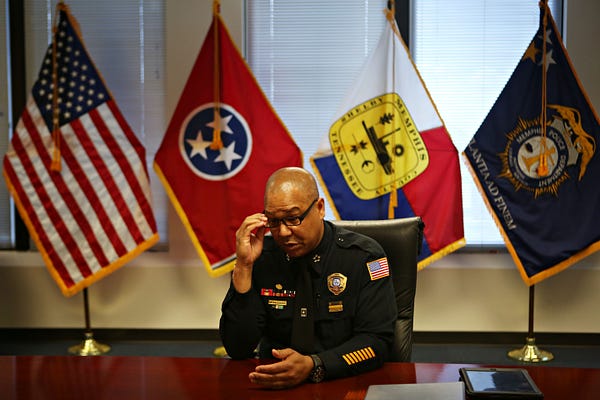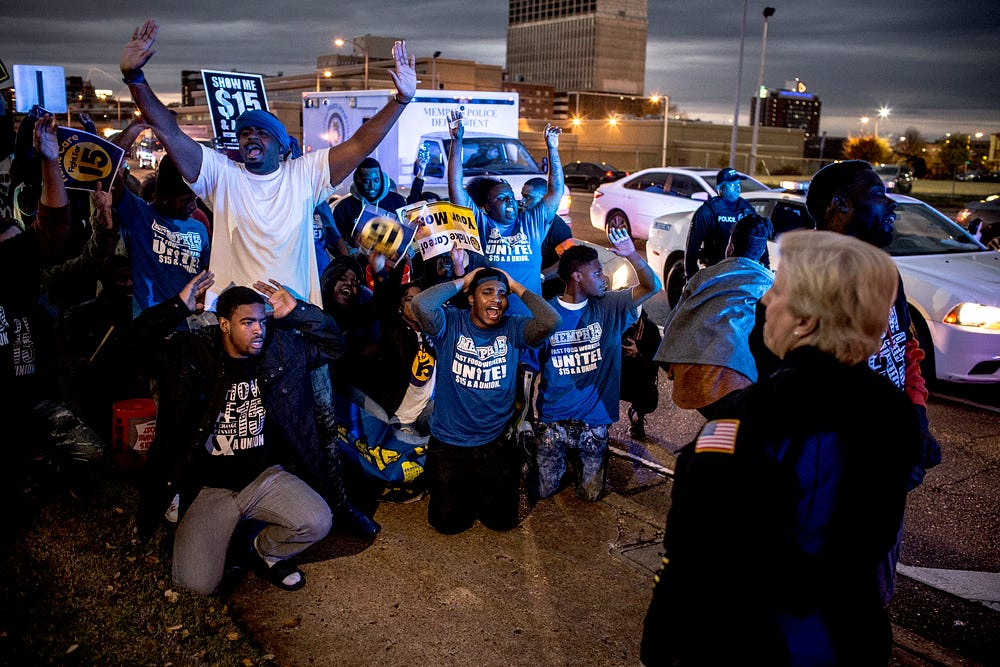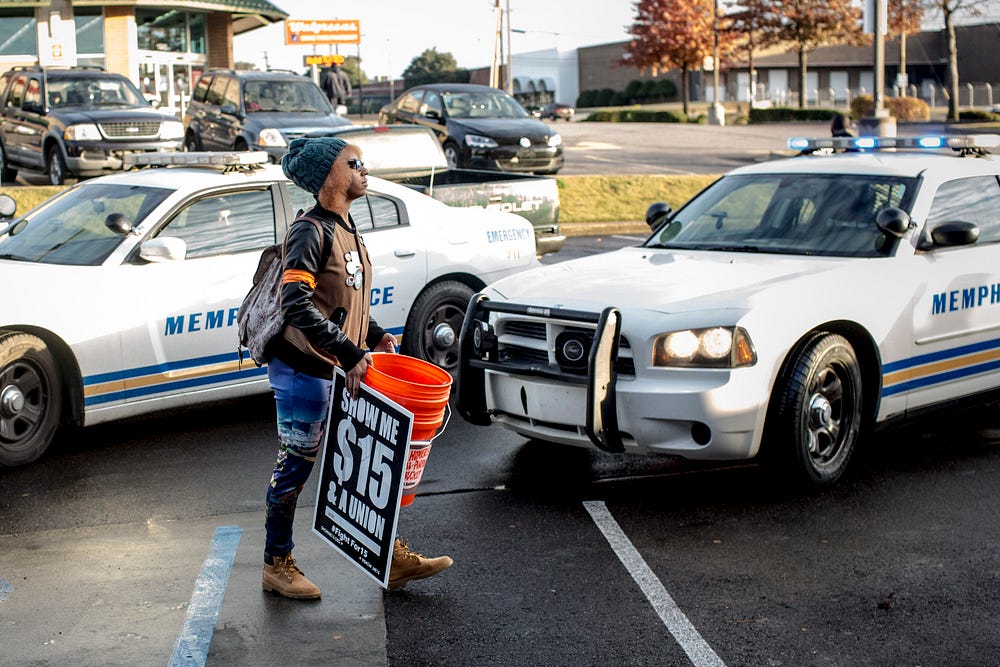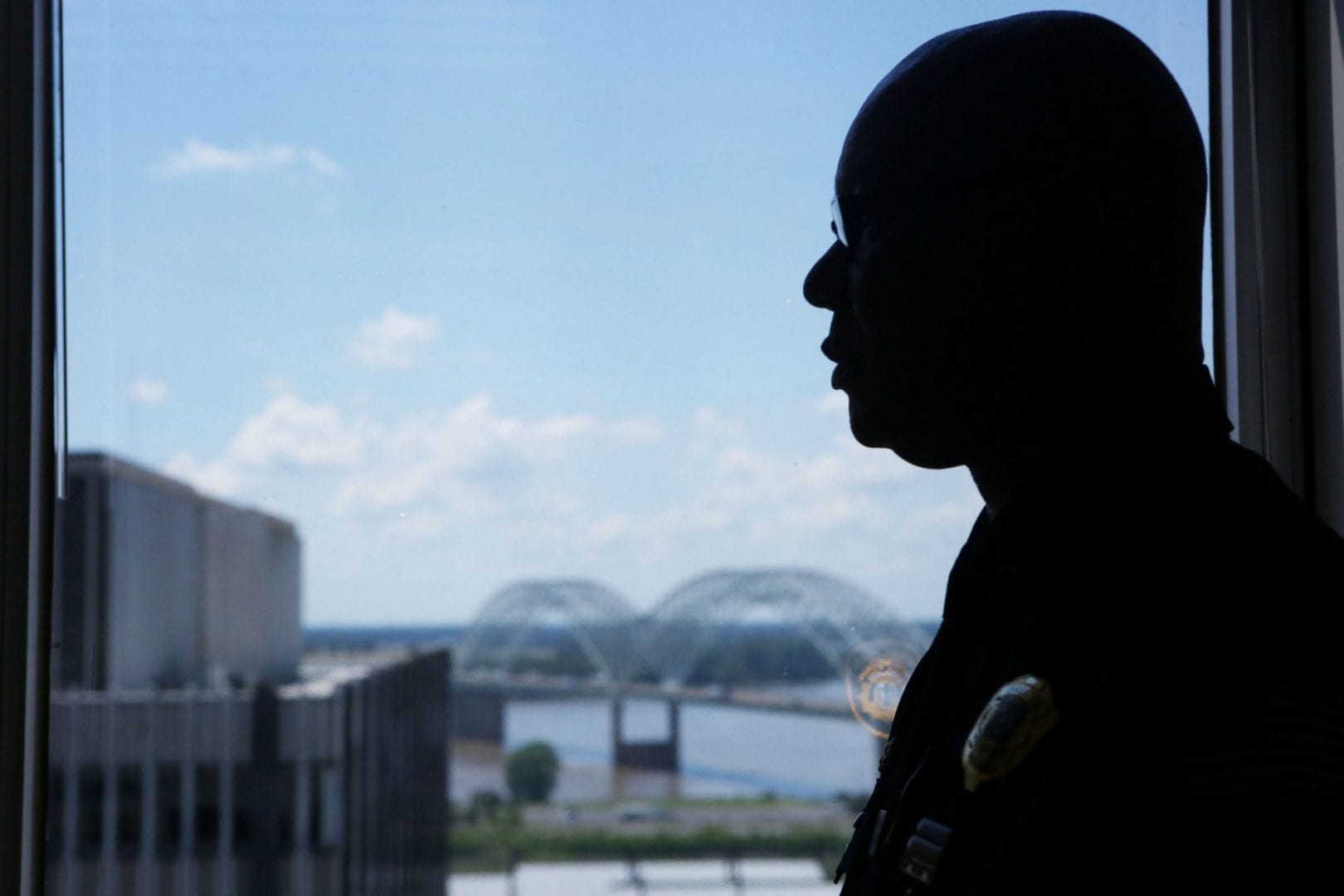When the interim director of the Memphis Police Department linked arms with organizers of a protest that shut down traffic on the city’s Interstate 40 bridge over the Mississippi River one year ago, he drew praise from observers far beyond the city limits. Even the UK’s BBC gave the director, Michael Rallings, a positive review in its coverage of the U.S. protests that followed the deaths last July of two black men — one in Louisiana, one in Minnesota — at the hands of police officers.

The organizers who joined Rallings in the amicable walk off the bridge that ended the protest on July 10 last year say they considered his act a promise of better communications to come between police and Memphis citizens. One year later, they say, it seems like an empty gesture.
Rallings himself says ongoing violence and an understaffed police forcestand in the way of progress in police-community relations.
A 27-year veteran of the police force, Rallings describes the bridge protest as “the most dangerous situation” of his career.
“I was really concerned about somebody dying that day because it’s very easy to fall off the bridge,” he said. “You have a mix of people and cars — those are not supposed to be mixed together.”




From the 12th floor of a city services building, Rallings recalls the protest while seated in a conference room overlooking the Hernando DeSoto Bridge that takes I-40 over the river. He says his goal was to get everyone off the bridge safely by reasoning with the organizers about their list of demands.
“They went down their laundry list of items, and I asked them, ‘Do you think that’s going to happen in the next hour or two hours?’”
All parties agreed to continue the conversation in a calmer environment, and the next day a town hall meeting assembled, attended by Memphis Mayor Jim Strickland and moderated by community leaders. But many walked out in frustration when no action was taken, a situation Rallings says was out of his control.
“If you go back and look at the tapes, we didn’t control the conversation,” said Rallings.
Strickland subsequently responded in writing to 90 questions submitted at the meeting, mostly about police brutality against black communities.
One item on the list was a call for Rallings’ permanent appointment as police director — the only demand that came to fruition. The rest of the demands, Rallings says, are more complicated.
“What was brought to me that day was so many things I did not have control over,” said Rallings. “I can’t fix the schools. Someone said, ‘We need jobs.’ Well, OK, I’m trying to hire 500 police officers. If you want to be a police officer or dispatch, I can help you.”
Though he praised officers who sometimes step up to assist citizens with food or rides to school, he says problems that disproportionately affect minorities — access to quality education, jobs with living wages, oppressive poverty — don’t fall in his jurisdiction.
“We do do these things … but we need the other 650,000 Memphians to do their part also. It takes an entire community to address these very complicated issues.”
And immediately after the protesters came off the bridge, he had his own request.
“What I asked that night was, ‘How about no killings for thirty days?’ And we know that didn’t happen because 2016 was our worst year for homicidessince 1993.”
A total of 228 homicides were ruled non-justifiable last year. And in answer to community activists who point out that poverty and violence are linked, he says, “You can be poor, but that doesn’t give you the right to victimize other poor people.”
Police killings of minority victims has inspired hundreds of Black Lives Matter protests since Trayvon Martin was shot and killed by a neighborhood watch volunteer in Sanford, Florida, in 2014. The list of victims includes Alton Sterling, Philando Castile, Tamir Rice and Walter Scott.

Rallings cites an estimate from the Memphis Police Department’s Real Time Crime Center to make his point that the statistical chance that an officer will shoot a civilian in Memphis is “very small.”
“So you’re talking about two million encounters (between police and civilians) every single year.… On average, for the last five years we average 14 officer-involved shootings, so we take those 14 officer-involved shootings, and we compare that to the two million contacts,” he said. “You have a very small chance of being involved in a shooting from a police officer.”
The director says officers have to deal with both the strains that fall on society’s poorest and the violence linked to that poverty.
“Yes, we need to address any issue where our citizens feel unsafe when they have an encounter with law enforcement. But then we have to talk about the thousands of acts of violence from citizens,” he said.
“So, when people say, ‘Director, I want you to do all of these things,’ I say, ‘I really want to … but I keep tripping over dead, black bodies … and it gets me distracted.”
Common Fault Lines
The common ground between Rallings and community organizers diverged at the eastbound exit ramp from I-40 to Riverside Drive, where police and protesters unlinked arms after ending the bridge protest. While they all agree the event ended peacefully, both sides say that since then, there’s been no change in the pressures that brought them there.
Keedran Franklin, organizer for Fight for $15, which supports a minimum-wage increase, was present at both the start and finale of the protest. He locked arms with Rallings in the peaceful end of the event that Mayor Strickland the next day called the “Memphis Model.”
“It kind of hyped me up, y’know?” Franklin said. “Like, ‘People are being heard.’” His sentiment began fading the next day at the hastily organized town hall meeting, the only one of its kind so far.
Other factors play into lost faith. One pending lawsuit filed by the American Civil Liberties Union on behalf of community organizers alleges that the MPD violated First Amendment rights of protesters by targeting some on a list of people who required a police escort when entering City Hall.


More than 80 people were on the “blacklist,” including Mary Stewart, whose son Darrius Stewart was shot and killed by an officer in 2015 after a traffic stop in Memphis.
The settlement terms of a second suit, this time filed by Fight for $15, required the city to admit it erred in blacklisting some organizers and to appoint a police liaison to coordinate public demonstrations and protests.

The bridge protest was followed by other peaceful marches — the Memphis offshoot of the Women’s March, another against President Trump’s immigration ban — that drew thousands to Downtown streets along with a significant police presence.
Like Rallings, United Campus Workers organizer Jayanni Webster believes that people rely on the police too often as the first solution for society’s problems. But Webster, 28, does not believe as Rallings does that more police officers are needed.
“It props up the police as those who are the only ones who can make a difference in this city, the only ones who have the best interest of this city in mind, and the only ones who have the skills and the desire to make this city a better place,” Webster said. “And it’s not true, it’s not true.”
The 2017 budget for police services in Memphis totals almost $256 million. By contrast, just over $4 million is earmarked for housing and community development. Grassroots organizations such as the Mid-South Peace and Justice Center, Memphis Center for Independent Living and the Memphis Bus Riders Union have argued that more of the city’s budget should go to public transportation, public housing and social services for low-income residents.
‘The Hunger for Good Policing’
Marcus Pohlmann, a political science professor at Rhodes College, described Rallings’ walk with protesters off the bridge as an “adept political action on his part,” and thinks the police director played a key role in preventing disruption at the protest.
But Pohlmann isn’t optimistic about police and community relations in Memphis and across the country.

Protecting poor neighborhoods without oppressing them is a balancing act, he said.
“Lives of the poor can be much more negatively affected by criminals than the police,” Pohlmann said. “You can forget that it’s not just police misconduct, but the hunger for good policing.”
The MPD is more than halfway through the first year of a U.S. Department of Justice review of community policing and use-of-force policies. The voluntary review, requested by Strickland shortly after he was sworn in as mayor, is expected to take as long as two years.
While the bridge protest is a year in the past, Webster still considers it a reference point.
“I think we have to continue to reflect and learn lessons from the bridge, so that it’s not a particular moment that we look at, but part of the growing movement that we have to have in Memphis to make sure that people get free.”


